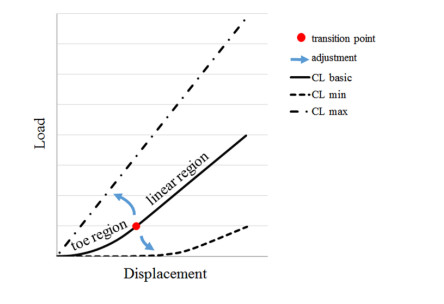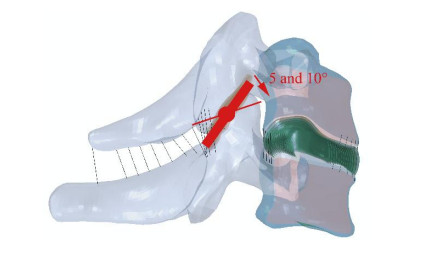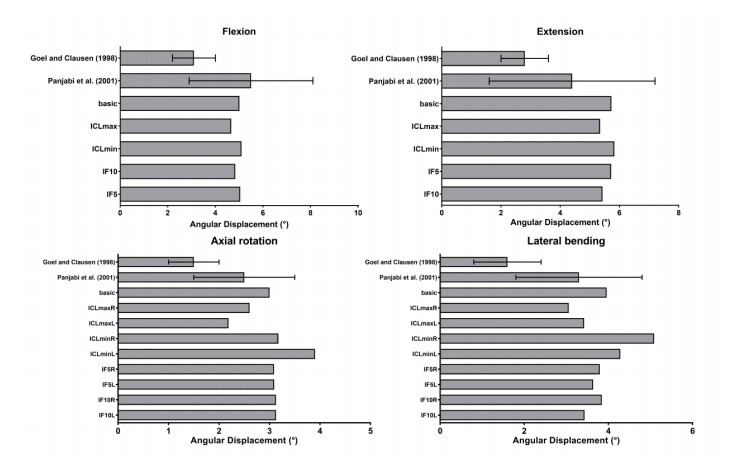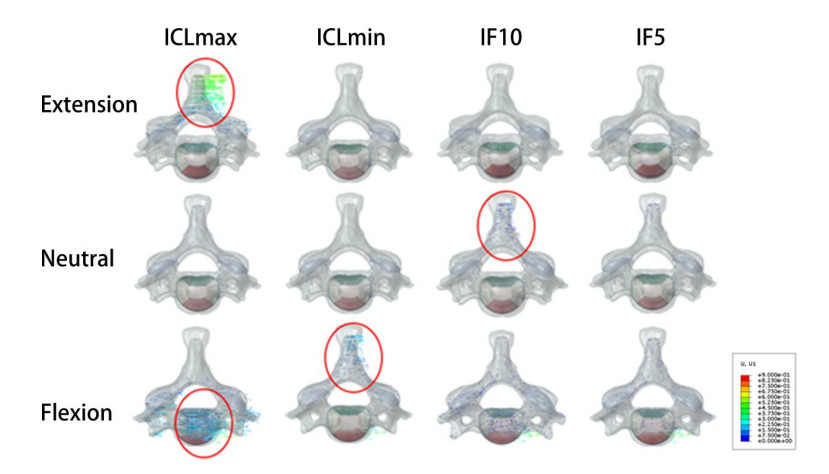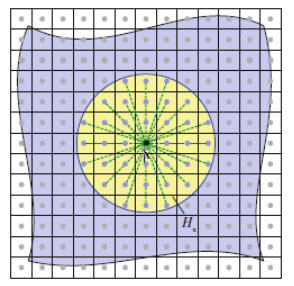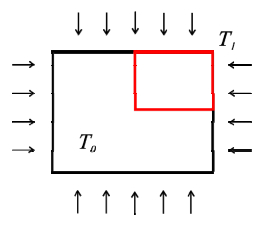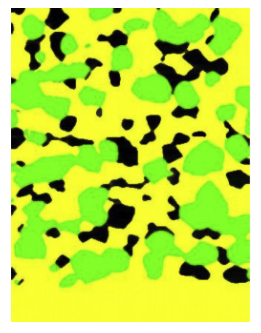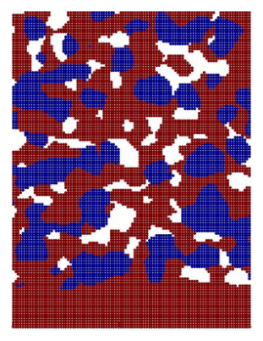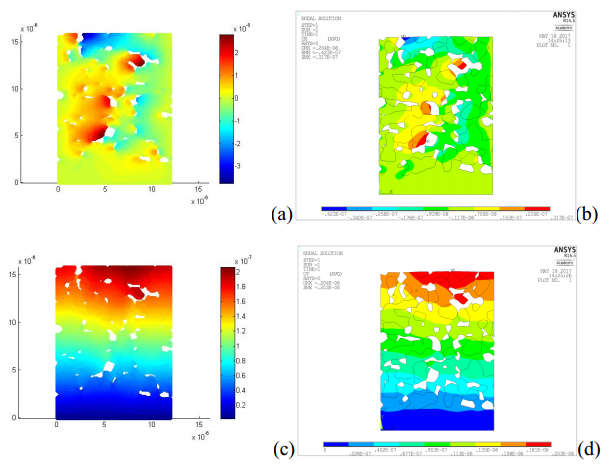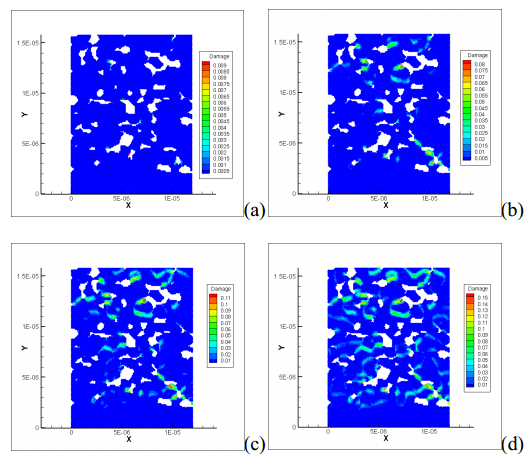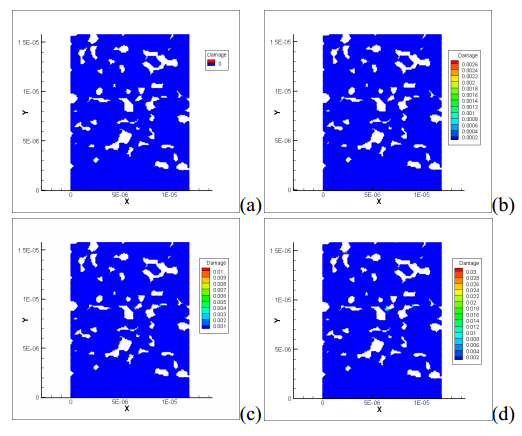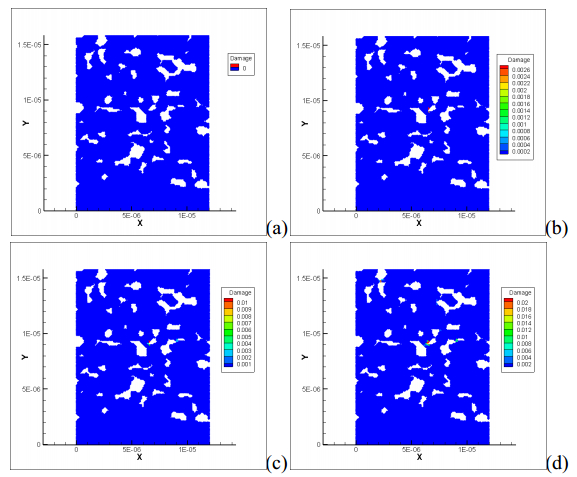Solid oxide fuel cell (SOFC) is widely used in hybrid marine propulsion systems due to its high power output, excellent emission control and wide fuel suitability. However, the operating temperature in SOFC will rise up to 800–1000 ℃ due to redox reaction among hydrogen and oxygen ions. This provides a suitable environment for ions transporting through ceramic materials. Under such operation temperatures, degradation may occur in the electrodes and electrolyte. As a result, unstable voltage, low capacity and cell failure may eventually occur. This study presents thermomechanical analysis of a porous SOFC cell plate which contains electrodes, electrolytes and pores. A microscale specimen in the shape of a plate is considered in order to maintain uniform temperature loading and increase the accuracy of estimation. A new computational technique, peridynamics, is utilized to calculate the deformations and stresses of the cell plate. Moreover, the crack formation and propagation are also obtained by using peridynamics. According to the numerical results, damage evolution depends on the electrolyte/electrode interface strength during the charging process. For weak interface strength case, damage emerges at the electrode/electrolyte interface. On the other hand, for stronger interface cases, damage emerges on pore boundaries especially with sharp corner.
1.
Introduction
Degeneration of spinal articular facet joint and related structures leading to spatial position deviations and abnormal functional activities can cause neck pains and related symptoms, which are surrounded by abundant micro-nerves and vascular distributions [1]. The most common risk factors for spinal articular facets and related structures' degeneration include trauma, chronic lesion, the posture of working and living, etc. In the clinic, it is generally believed that this status of the spinal articular facet can accelerate the degeneration of the structures and induce corresponding symptoms. However, to our best knowledge, the reports referred to quantitative research were currently rare.
The degeneration of cervical spinal articular facet joint comprises the changes of the material properties of the joint capsule ligament and the morphological variations of the articular facet joint. It is well known that spine ligaments not only control the motion of the segments, but also maintain spine stability. As major cervical ligaments, capsular ligaments (CL) are one of the fundamental supportive structures in the region [2]. In anatomy, the articular facet joint and CL are paired, while joint bears part of the head weight, and CL stabilizes the activities of the corresponding joint.
In the study of ligament biomechanics, researchers generally attempted to introduce the ligament resection sequentially for quantification of the mechanical effects of a certain type in the cadaveric specimens [3,4]. But, these studies only stimulated the status of complete ligaments rupture, which was incompatible with our research purpose. Previous studies demonstrated that individual differences in mechanical and material properties are ubiquitous, subjected to a variety of factors including age, gender, and cumulative micro-trauma, etc. [5,6,7]. For instance, aging would reduce the elastic modulus of ligaments, and some specific ligaments of males have a higher modulus than female, naturally [6,8]. In addition, certain sub-failure trauma did not completely break the ligaments, but repetitive loading would significantly reduce the rigidity of the ligaments [9]. Therefore, the relationship between the mechanical sensitivity of these CL and stiffness variation is critical to understand the biomechanical effects of CL degeneration.
Pal et al. [10] reports the direction of the cervical facet joint systematically with specimens, and the standard deviation of the middle and lower cervical spine facet joints related with the vertebral level was range from 6.16° to 9.43°. Meanwhile, the angle difference was found not only among individuals, but also between the bilateral sides of the same cervical spine. An epidemical report assessed 200 cervical spondylosis patients with axial CT scan imaging and demonstrated that aging and facet tropism concerning the sagittal plane were associated with the facet degeneration [11]. Therefore, depth understanding how physiological or pathologic changes of anatomical structural respond to physiological activities will guide us clinical practices reasonably. It is necessary to investigate the mechanism underlying physiological or pathologic changes of anatomical structural respond to physiological activities, which can provide useful information in clinical practices.
Previous literatures showed that the C5–C6 segment was more inclined to be injured, and was one of the most degenerative segments reasonably [12,13]. Although a few authors reported some meaningful data through in vivo and in vitro studies at present [4,6], biomechanical effects cannot be quantified and accurately analyzed through conventional methods. For an instant, the tissues' property materials and spine functional activities of the formalin soaked cadaver specimen was distinctive with the live human body. Besides, there is a complex additive effect of the intact cervical spine physiological function, which could hardly figure out the microstructure changes referring to the geometrical structure and properties separately. Also, the in vivo studies mostly relied on radiological imaging measurement, which was difficult to evaluate the spinal three-dimensional movement.
FE analysis has been widely used by the researchers in biomechanical experiments and has illustrated great flexibility for customizing of various parameters for specific purposes [14,15]. The cervical disc degeneration led to intervertebral space stenosis, increased the facet joint pressure, and caused joint capsule and other soft tissue injury [16]. Moreover, the articular facet injury accelerated disc deterioration [17].
The hypothesis of the study is that unilateral ligament stiffness and sagittal angle changes in articular facet joints could break the balance of stress distribution under specific activities. Therefore, this study was aimed to quantitatively analyze the biomechanical changes and to comprehend the inherent law related to the potential damages and mechanical properties of C5–C6 segment's unilateral articular capsule ligament and corresponding joint sagittal angle under physiological activities.
2.
Materials and methods
2.1. Model development
As shown in Figure 1, an anatomically accurate 3-dimensional FE model of the C5–C6 segment had been previously developed based on a 30-year old healthy male subject in a supine position [18]. The subject did not have any history of neck pain and related disorders, and any spine degeneration, malformation, variation, trauma and any other factors that could affect the experiment. The C5–C6 segment was the most frequently affected by disc degenerative disease [19]. Computed tomography (CT) images of a 0.625 mm slice was scanned. The CT images of C5–C6 segment were processed with commercial software Mimics 10.1 (Materialise Inc., Leuven, Belgium), Geomagic Studio 11 (Geomagic, Inc., Research Triangle Park, NC, USA), Hypermesh 11.0 (Altair Engineering, Inc., Executive Park, CA, USA) sequentially. The components of the FE model included two vertebrae, one intervertebral disc and major ligaments, and the vertebra bone composed of cortical, cancellous bones and endplates, which were modeled with hexahedron elements with isotropic, linear mechanical properties. Each articular facet was shell elements and the initial gap between the joints was 0.4 mm.
The inter-facets were designed to frictionless surface to surface contact. Intervertebral disc consisted of an incompressible nucleus pulposus, annulus ground substance and embedded fibers, and nucleus pulposus was created as a fluid cavity which constituted 25% of the disc volume and had a bulk modulus of 2000 MPa. The annulus fibers were modeled as rebar elements and the matrix volume of fibers concerning the surrounding ground substance was varying from 23% in the outer layer to 5% in the inner, while the orientation of fibers ranged from ± 25° in the outer layers to ± 45° in the inner. Annulus ground substance was modelled with hexahedral elements with nonlinear hyperelastic mechanical properties [20]. Five major ligaments, anterior longitudinal, posterior longitudinal, interspinous, capsular, and flaval ligaments, were attached to nonlinear tension-only truss element. Detailed material properties assigned to the model obtained from literature were listed in Table 1.
2.2. Model validation
We applied 1 Nm pure moment on the three planes to produce flexion, extension, lateral bending and axial rotation, and followed a 73.6 N load near the center of C5 and C6 for head physical gravity simulation. The predicted ranges of motion (ROM) of the C5–C6 segment model under same loading conditions with published experimental data were used for validation [27].
2.3. FE analysis
The basic load-displacement curve of capsular ligament was obtained from the literature by using average value of each parameter [23], the parameters controlling the load-displacement curve included the displacement, force at the transition point and stiffness of the linear region. The minimum stiffness of capsular ligament was created by raising the former one parameter and reducing the latter two parameters by one standard deviation. The maximum stiffness of capsular ligament was created using the opposite approach, but the toe region was adjusted to a linear pattern so that the slope of the toe region was no greater than the slope of linear region. Therefore, each ligament would have three load-displacement curves which served as average, minimum and maximum stiffness.
To evaluate the biomechanical effects of capsular ligament in various stiffness on C5–C6 segment, we changed the material properties of unilateral capsular ligament (left) by the minimum or maximum stiffness separately for ligament degeneration simulation as shown in Figure 2, while the remaining ligament (right) maintained the average value, which were Model 1 (minimum stiffness capsular ligament) and Model 2 (maximum stiffness capsular ligament). Variations in ligament stiffness could be created by modifying these values obtained from the literature [18,27].
The average cervical articular facet tropism was 56.36° ± 8.82° [10], and the facet angle of our basic model was about 66° with the horizontal plate of upper endplate. Referred to the similar study of lumbar spine for mechanics analysis of asymmetric model [21], we altered the angles of left articular facets pair forward 5° and 10° separately to imitate the unilateral facet joint degeneration, which were Model 3 (M3) (61°) and Model 4 (M4) (55°), respectively Figure 3.
Above all, five FE models were compared in this study. The loadings and boundary conditions of basic model M0, and adaption models of M1, M2, M3 and M4 were maintained to calculate the segmental kinematics and disc stress distribution.
3.
Results
3.1. Changes of C5–C6 segmental movement
As shown in Figure 4, the angular displacement of C5 during flexion, extension, lateral flexion, and rotation movement of M1 increased under physiological loading. However, the ranges of six degrees of M2 decreased. For the changes of C5 articular facet joint sagittal angle, we simulated the cervical flexion activities under the 1 Nm moment, and the resulted angels of M0, M3, M4 were 5.01°, 5.05°, and 4.84°, separately. And during the extension, the angles of M0, M3, and M4 were 5.73°, 5.72°, and 5.43°, separately. During the axial rotation, we found that the angle increased in M3 and M4 comparing to M0, furthermore, the angle of M4 was larger. However, the angle decreased in M3 and M4 during the lateral bending, and M4 had the larger magnitude of the reduction.
3.2. Displacement of C5 segmental spatial position
Figure 5 showed the displacement of all asymmetric models (i.e., M1, M2, M3 and M4) in the coronal plane during flexion, extension and neutral position. In detail, the spinous process of C5 of M1 turned to the left during flexion, while the vertebral body of C5 of M2 turned to the left. During extension, the spinous process of C5 of M2 turned to the left. M4 turned to the left under the head weight in neutral position. The displacements were remarked by red circles.
3.3. Abnormal intervertebral disc stress distribution
As showed in Figure 6, stress distribution of C5–C6 intervertebral disc during flexion and extension, abnormal were demonstrated in the all asymmetric models (i.e., M1, M2, M3 and M4), however, insignificantly.
During axial rotation of the cervical spine, it could cause a comparatively large effect on stress concentrations on nucleus pulposus. Under the right rotation, the pressure in the nucleus of M2 was higher than M0, but M1 was lower than M0. And, M2 was lower than M0 under the left rotation. Besides, the amplitude of M4's ascending curve was lower than M0 during right rotation, but it was higher during left rotation. And, under the controlled axial rotation angle, the curve trends of M1 and M2 were consistent with moment loading condition, but the M2 was magnified as showed with the red lines.
During left lateral bending, the pressure in the nucleus of M1 was higher than M0, but M2 was lower than M0, and the amplitude of M4's ascending curve was lower than M0. However, M2 was higher than M0, and the amplitude of M4's ascending curve was higher than M0 during right lateral bending. Additionally, M3 and M4 were both higher than M0 under the same angular displacement of lateral bending.
4.
Discussion
The human facet joint, a synovial joint located on the posterior-lateral spine, is highly susceptible to degenerative changes and plays a significant role in morbidities [28]. Previous studies reported that the range of activity of the lower cervical spine decreased with aging [29], which was attributed to the reduction of spine disc height and formation of osteophyte owing to the aging [2,23,30]. This study showed that we controlled the angular displacement of C5 articular joint within a certain range (about 2° in segmental rotational angle), the C5–C6 disc distribution of all asymmetric models (M1, M2, M3 and M4) had no significant difference with the symmetrical model (M0) during the rotation, lateral flexion activities. The results indicated that avoidance of excessive activity benefited the asymmetric degeneration cervical spine disc.
Degeneration of human spine emerges with aging naturally, while would be accelerated with repeated sub-injury, trauma and inclined the mechanical strength of soft tissues, ie., ligaments [7,31,32]. The results showed that variation of joint capsule ligament rigidity (M1, M2) had a limited restriction during flexion and extension but more obvious changes during rotation, lateral flexion. We found that M1 increased the rotation range of ipsilateral side (left), while M2 reduced, and both had limited effect on the contralateral side (right). During extension, the C5 spinous processes of M2 appeared to the ipsilateral side (left) while the C5 vertebra deviation to the same side during flexion, which was caused by the limitation of high stiffness of capsule ligament. In contrast, the low stiffness capsule ligament of M1 increased the ipsilateral axial rotation, and therefore the C5 spinous processes turned to ipsilateral side during flexion. In summary, the displacement of M2 was more distinct than M1 during activities, it implied that ligament lesion lead to objective segment instability at the initial stage, but with the ligament calcification changed, it would produce a kind of protective stability through limiting the neck activity range.
For the degeneration of the articular joint facet angel, M3 and M4 increased the nucleus pulposus pressure with and without controlled angular displacement during axial rotation. During lateral flexion, M3 and M4 increased the nucleus pulposus pressure significantly, which was greater than turning to the contralateral side. The result was consistent with a radiology imaging study [12], which showed that the larger angle of cervical facet joint declined the anti-shear ability and led to more vulnerable of the disc annulus fiber in the same side. Interestingly, when we controlled angular displacement, the disc stress distribution of M3 and M4 was similar and both higher than M0. This study suggested when the unilateral articular facet joint was rotated forward and closer to the horizontal plane; the range of axial rotation would be increased slightly, which was consistent with previous report [33]. Additionally, the disc pressure increasing was relating to the segment activity.
There were some limitations in this study. Firstly, in vivo and in vitro experiments are needed to reliably validate and supplement in future studies. Even though we adjusted the capsule ligament stiffness according to the load-displacement curve, but the interactions between the tissue's stiffness, geometrical morphology and other material properties were omitted. Secondly, we did not address the analysis of cervical lordosis, neither of other articular facet joint sagittal angle corresponded to different spine segment and skeletal muscles, which affected the spine kinematics [11,34]. Therefore, these findings with individual characteristics should be explained cautiously to other spine segments. The further studies should focus on these variable factors for understanding thoroughly of the spine biomechanics with more optimized experimental design and powerful computer analysis capabilities.
5.
Conclusion
The capsule ligament stiffness made an impact on segmental mobility and vertebral spatial position, and the sagittal angle of articular facet joint exerted an influence on disc pressure distribution. The findings demonstrated a vicious cycle of the cervical spine degeneration, which confirmed that it is a protective calcification for stability alternated with progressive degeneration for instability.
Acknowledgements
Supported by the National Natural Science Foundation of China (No. 81804114, 81503596, 81473702).
Conflict of interest
All authors declare no conflicts of interest in this paper.
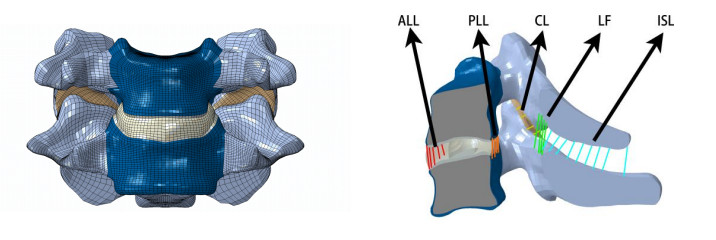









 DownLoad:
DownLoad:
